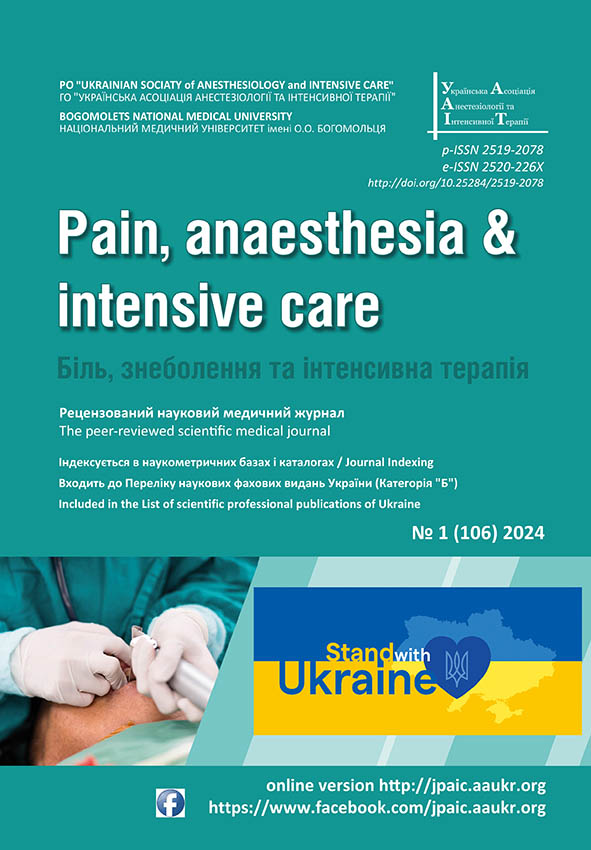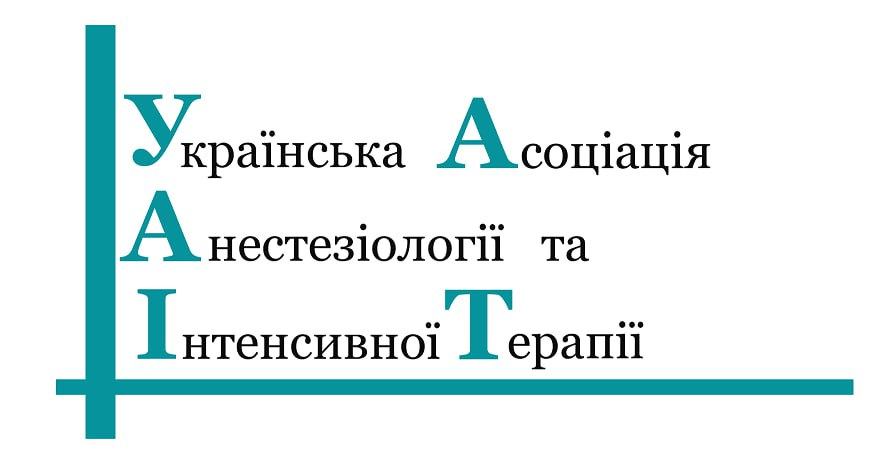МОДИФІКОВАНА ЗАГАЛЬНА АНЕСТЕЗІЯ ПРИ ПЛАНОВОМУ КЕСАРСЬКОМУ РОЗТИНІ
DOI:
https://doi.org/10.25284/2519-2078.1(106).2024.300696Ключові слова:
загальна анестезія, тотальна внутрішньовенна анестезія, штучна вентиляція легень, кесарів розтин, клонідин, парацетамолАнотація
Вступ. Загальна анестезія при кесарському розтині використовується при наявності протипоказів до субарахноїдальної анестезії, з сумарною частотою – до 20 %. В медичній спільноті відсутній єдиний уніфікований алгоритм загальної анестезії для даного різновиду оперативних втручань. Основними недоліками загальної анестезії при кесарському розтині є: високий відсоток випадкового збереження свідомості пацієнта під час операції (1:670) та виражена стресорна реакція на операційну травму.
Мета дослідження – порівняти «рутинну» методику тотальної внутрішньовенної анестезії зі штучною вентиляцією легень при планових кесаревих розтинах та модифіковану загальну анестезію з додаванням ад’ювантів.
Матеріали та методи: Було проведено оцінку 60 кейсів пацієнтів у власній практиці. Усі пацієнти були рандомним методом розділені на 2 групи, по 30 пацієнтів у кожній. Перша група – «рутинна» методика тотальної внутрішньовенної анестезії із штучною вентиляцією легень, друга група – модифікована загальна анестезія. В якості ад’ювантів (друга група) використовувались внутрішньовенні форми медичних препаратів: ацетамінофен (1000 мг) і клонідин (100 мкг) за 30 хвилин до планового оперативного втручання. Періопераційне ведення пацієнтів і моніторинг відповідали рекомендаціям Американської Асоціації Анестезіологів із додаванням біспектрального індексу та визначення рівнів стрес-індукованих субстанцій (глюкоза, кортизол). Проводилась оцінка новонароджених за шкалою Апгар і аналіз газів пуповинної крові (венозний зразок) Для статистичної обробки даних використовувався двосторонній t-критерій Стьюдента (p value = 0,001; t-критерій Стьюдента < –3,466 і > 3,466).
Результати: Між двома групами була відсутня статистично значима різниця у вихідних середніх показниках. Отримані результати продемонстрували наявність статистично значимих відмінностей між двома групами: середній артеріальний тиск на етапі інтубація трахеї/початок операції (t = 24,3); середній артеріальний тиск – вилучення новонародженого (t = 25,5); частота серцевих скорочень на етапі інтубація трахеї/початок операції (t = 11,7); частота серцевих скорочень – вилучення новонародженого (t = 21,3); біспектральний індекс інтубація трахеї/початок операції (t = 4); біспектральний індекс вилучення новонародженого (t = 8,2); оцінка новонароджених за шкалою Апгар на 1 хвилині (t = –4,5); pH пуповинної венозної крові (t = –5,44); pСО2 пуповинної венозної крові (t = 4,8); pО2 пуповинної венозної крові (t = –7,6); глюкоза крові вилучення новонародженого (t = 10,9); кортизол плазми крові вилучення новонародженого (t = 25,4).
Висновки. Враховуючи отримані результати, модифікована загальна анестезія з додаванням ад’ювантів (клонідин, ацетамінофен) в періоді до народження дитини при плановому кесаревому розтині має обґрунтовані (статистично значимі) переваги над «рутинною» методикою загальної анестезії.
Посилання
Chien P. Global rising rates of caesarean sections. BJOG 2021; 128: 781 – 2. https://doi.org/10.1111/1471-0528.16666.
 |
|  |
| 
CDC – Births – Method of Delivery. Last accessed 11.29.2020. https://www.cdcgov/nchs/fastats/deliveryhtm
Society for obstetric anesthesia and perinatology. Last accessed 11/15/2020. https://soap.org/grants/center-of-excellence.
Cobb BT, Lane-Fall MB, Month RC et al. Anesthesiologist specialization and use of general anesthesia for cesarean delivery. Anesthesiology 2019; 130: 237 – 46. https://doi.org/10.1097/ALN.0000000000002534.
 |
|  |
| 
Ring L, Landau R, Delgado C. The current role of general anesthesia for cesarean delivery. Curr. Anesthesiol. Rep. 2021; 11: 18 – 27. https://doi.org/10.1007/s40140-021-00437-6.
 |
|  |
| 
Rollins M., Lucero J. Overview of anesthetic considerations for Caesarean delivery. Br. Med. Bull. 2012; 101: 105 – 25. DOI: 10.1093/bmb/ldr050.
 |
|  |
| 
Robins K, Lyons G. Intraoperative awareness during general anesthesia for Caesarean delivery. Anesth Analg. 2009; 109: 886 – 90. DOI: 10.1213/ane.0b013e3181af83c1.
 |
|  |
| 
Datta S., Kodali B. S., Segal S. Obstetric Anesthesia Handbook – 5th ed. – New York: Springer-Verlag, 2010. – 488 p. DOI: 10.1007/978-0-387-88602-2
American Society of Anesthesiologists Task Force on Intraoperative Practice advisory for intraoperative awareness and brain function monitoring: a report by the Аmerican society of anesthesiologists task force on intraoperative awareness. Anesthesiology. 2006; 104 (4): 847 – 64. DOI: 10.1097/00000542-200604000–00031.
 |
|  |
| 
Landau R., Bollag L., Ortner C. «Chronic pain after childbirth,» International Journal of Obstetric Anesthesia, vol. 22, no. 2, pp. 133 –145, 2013. DOI: 10.1016/j.ijoa.2013.01.008.
 |
|  |
| 
Pandit JJ, Andrade J, Bogod DG. et al. 5th National Audit Project (NAP5) on accidental awareness during general anaesthesia: summary of main fi ndings and risk factors. Br. J. Anaesth. 2014; 113 (4): 549 –59. DOI: 10.1093/bja/aeu313.
 |
|  |
| 
McCombe K, Bogod DG. Learning from the Law. A review of 21 years of litigation for pain during caesarean section. Anaesthesia. 2018; 73 (2): 223 – 30. DOI: 10.1111/anae.14119.
 |
|  |
| 
Bollag L., Lim G., Pervez S. , Habib A. et al. Society for Obstetric Anesthesia and Perinatology: Consensus Statement and Recommendations for Enhanced Recovery After Cesarean. Anesth. Analg. 2021 May 1; 132 (5): 1362 – 1377. DOI: 10.1213/ANE.0000000000005257
 |
|  |
| 
White C., Doherty D., Henderson J. et al. Benefits of introducing universal cord blood gas and lactate analysis into an obstetric unit. Australia and New Zealand J. of Obstetrics and Gynaecology 2010; 50: 318 – 28. https://doi.org/10.1111/j.1479-828X.2010.01192.x.
 |
|  |
| 
Murdoch H., Scrutton M., Laxton CH. Choice of anaesthetic agents for caesarean section: a UK survey of current practice. Int. J. Obstet. Anesth. 2013; 22: 31 – 5. DOI: 10.1016/j.ijoa.2012.09.001.
 |
|  |
| 
Morris J., Acheson M., Reeves M. et al. Effect of clonidine premedication on propofol requirements during lower extremity vascular surgery: a randomized controlled trial. Br J Anaesth. 2005; 95 (2): 183 – 8. DOI: 10.1093/bja/aei172.
 |
|  |
| 
Hall JE, Uhrich TD, Ebert TJ. Sedative, analgesic and cognitive effects of clonidine infusions in humans. Br J Anaesth. 2001; 86 (1): 5 – 11. DOI: 10.1093/bja/86.1.5.
 |
|  |
| 
Khan FA, Ullah H. Pharmacological agents for preventing morbidity associated with the haemodynamic response to tracheal intubation. Cochrane Database Syst. Rev. 2013; 7: CD004087. DOI: 10.1002/14651858.CD004087.pub2.
 |
|  |
| 
Kutlesic M., Kutlesic R., Mostic-Ilic T. Attenuation of cardiovascular stress response to endotracheal intubation by the use of remifentanil in patients undergoing Cesarean delivery. J. Anesth. 2016 Apr.; 30 (2): 274 – 83. DOI: 10.1007/s00540-015-2118-5.
 |
|  |
| 
Littleford J. Effects on the fetus and newborn of maternal analgesia and anesthesia: a review. Can. J. Anesth. 2004; 51: 586 – 609. DOI: 10.1007/BF03018403.
 |
|  |
| 
Safavi M., Honarmand A., Azari N. Attenuation of the pressor response to tracheal intubation in severe preeclampsia: relative effi cacies of nitroglycerine infusion, sublingual nifedipine and intravenous hydralazine. Anesth. Pain. 2011; 1: 81 – 9. DOI: 10.5812/kowsar.22287523.1782.
 |
| 
Huang C.J., Fan Y.C., Tsai P.S. Differential impacts of modes of anesthesia on the risk of stroke among preeclamptic women who undergo Caesarean delivery: a population-based study. Br. J. Anaesth. 2010; 105: 818 – 26. DOI: 10.1093/bja/aeq266.
 |
|  |
| 
FDA News Release. FDA issues fi nal rule on changes to pregnancy and lactation labeling information for prescription drug and biological products. Accessed August 1, 2019 at https://www.fda.gov/drugs/labeling/pregnancy-and-lactation-labeling-drugs-final-rule.
Buchanan M. L., Easterling T. R., Carr D. B. et al. Clonidine pharmacokinetics in pregnancy. Drug Metab. Dispos., 37 (4) (2009), pp. 702 – 705. DOI: 10.1124/dmd.108.024984.
 |
| 
Rajabi M., Razavizade MR., Hamidi-Shad M. et al. Magnesium Sulfate and Clonidine; Effects on Hemodynamic Factors and Depth of General Anesthesia in Cesarean Section. Anesth. Pain Med. 2020; 10 (5): e100563. DOI: 10.5812/aapm.100563.
 |
| 
Ebneshahidi А., Mohseni M. Premedication with oral clonidine decreases intraoperative bleeding and provides hemodynamic stability in cesarean section. Anesth. Pain Med. 2011; 1 (1): 30 – 33. DOI: 10.5812/kowsar.22287523.1337.
 |
| 
Fernandes H. S., Bliacheriene F., Vago T. M. et al. Clonidine Effect on Pain After Cesarean Delivery: A Randomized Controlled Trial of Different Routes of Administration. Anesth Analg. 2018; 127: 165 –170. DOI: 10.1097/01.aoa.0000547330.40214.90.
 |
|  |
| 
Gin T., Ngan-Kee W. D., Siu Y. K. et al. Alfentanil given immediately before the induction of anesthesia for elective Cesarean delivery. Anesth. Analg. 2000; 90: 1167 – 72. DOI: 10.1097/00000539-200005000-00031.
 |
|  |
| 
Sanchez Munoz M. C., De Kock M., Forget P. What is the place of clonidine in anesthesia? Systematic review and meta-analyses of randomized controlled trials. J. Clin. Anesth. 2017 May: 38: 140 – 153. DOI: 10.1016/j.jclinane.2017.02.003.
 |
|  |
| 
##submission.downloads##
Опубліковано
Як цитувати
Номер
Розділ
Ліцензія

Ця робота ліцензується відповідно до Creative Commons Attribution-NonCommercial 4.0 International License.
Автори, які публікуються у цьому журналі, погоджуються з наступними умовами:
a. Автори залишають за собою право на авторство своєї роботи та передають журналу право першої публікації цієї роботи на умовах ліцензії Creative Commons Attribution-NonCommercial 4.0 International License, котра дозволяє іншим особам вільно розповсюджувати опубліковану роботу з обов'язковим посиланням на авторів оригінальної роботи та першу публікацію роботи у цьому журналі.
b. Автори мають право укладати самостійні додаткові угоди щодо неексклюзивного розповсюдження роботи у тому вигляді, в якому вона була опублікована цим журналом (наприклад, розміщувати роботу в електронному сховищі установи або публікувати у складі монографії), за умови збереження посилання на першу публікацію роботи у цьому журналі.
c. Політика журналу дозволяє і заохочує розміщення авторами в мережі Інтернет (наприклад, у сховищах установ або на особистих веб-сайтах) рукопису роботи, як до подання цього рукопису до редакції, так і під час його редакційного опрацювання, оскільки це сприяє виникненню продуктивної наукової дискусії та позитивно позначається на оперативності та динаміці цитування опублікованої роботи (див. The Effect of Open Access).








